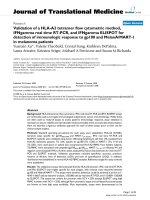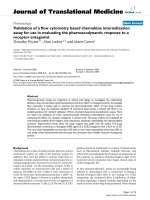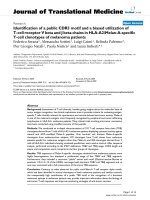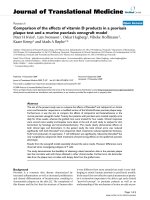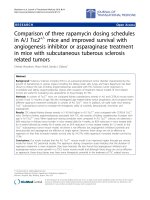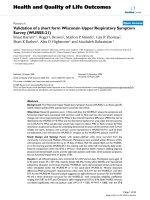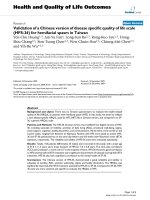báo cáo hóa học:" Comparison of a minimally invasive posterior approach and the standard posterior approach for total hip arthroplasty A prospective and comparative study" doc
Bạn đang xem bản rút gọn của tài liệu. Xem và tải ngay bản đầy đủ của tài liệu tại đây (796.6 KB, 7 trang )
RESEA R C H ART I C L E Open Access
Comparison of a minimally invasive posterior
approach and the standard posterior approach
for total hip arthroplasty A prospective and
comparative study
Bernd Fink
*
, Alexander Mittelstaedt, Martin S Schulz, Pavol Sebena, Joachim Singer
Abstract
Background: It is not clear whether total hip arthroplasty performed via a minimally invasive approach leads to
less muscle trauma compared to the standard approach.
Materials and methods: To investigate whether a minimally invasive posterior approach for total hip arthroplasty
results in lower levels of muscle-derived enzymes and better post-operative clinical results than those obtained
with the standard posterolateral approach fifty patients in both groups were compared in a prospective and
comparative study. The following parameters were examined: muscle-derived enzymes CPK, CK-MM and myoglobin
pre-operatively, 24 and 48 hours post-operatively, CRP and hemoglobin on the third postoperative day, loss of
blood, daily pain levels, the rate of recovery (time taken to attain predefined functional parameters), the Oxford Hip
Score, the SF-36 score and the WOMAC score pre-operatively and six weeks post-surgery, the position of the
implant and the cement coating by post-operative X-ray examination.
Results and Conclusions: The minimally invasive operated patients exhibited a significantly lower loss of blood,
significantly less pain at rest and a faster rate of recovery but the clinical chemistry values and the other clinical
parameters were comparable.
Background
A number of different so-called minimally invasive
approaches are being used more and more for total hip
arthroplasty. In principle they can b e divided into two
groups: the muscle-sparing approaches and the mini-
incision approaches. The former group, where muscles
are not cut, includes the two-incision technique, the
anterolateral mini-approach and the direct anterior mini
approach [1-4]. The mini-incision group approaches
involve a shorter incision in the skin and less muscles
are detached than in the corresponding standard
approach. This group includes the mini-incision lateral
approach and the mini-posterior approach [5-8].
In general, the minimally invasive approach is
described as having a lower degree of trauma for the
soft -tissues and, in particular, for the muscles . This opi-
nion is based on the fact that the loss of blood is lower,
rate of recovery is faster, the post-operative level of pain
is lower and patients are released sooner from hospital
[1-3,8-15]. However, it is unclear whether muscle
trauma is really reduced as a result of the smaller sized
access incisions and the lack of, or lower amount of,
muscle detachment because, normally, the surgical
hooks and retractors used during the operation exert a
much greater pressure on, and cause extensive contu-
sions in, the muscle tissue. Indeed, measurable muscle
damage has been identified in all the currently used
minimally invasive approaches tested in cadaver studies
[16-18].
Thelowerlevelofsofttissuetraumaisparticularly
questionable for the mini-incision techniques. Goldstei n
et al. [19], Wright et al. [20], W oolson et al. [15] and
Ogonda et al. [21] did not observe any objectiv e clinical
advantages of the mini-posterior approach when
* Correspondence:
Department of Joint Replacement, General and Rheumatic Orthopaedics,
Orthopaedic Clinic Markgröningen gGmbH, Kurt-Lindemann-Weg 10, 71706
Markgröningen, Germany
Fink et al. Journal of Orthopaedic Surgery and Research 2010, 5:46
/>© 2010 Fink et al; l icensee BioMed Central Ltd. This is an Open Access article distributed under the terms of the Creative Commons
Attribution License (http://c reativecommons.org/licenses/by/2.0), which permits unrestricted use, distr ibution, and reproduction in
any medium, provided the original work is properly cite d.
compared to the standard posterolateral approach. It
must be said, however, that the minimal invasion in
these studies was only at the level of a shorter skin inci-
sion. In contrast, Sculco et al. [8,22] and DiGioia et al.
[10] observed a smaller loss of blood and a faster post-
operative recovery following a mini-posterior approach
while Inaba et al. [6] and Dorr et al. [11] reported a
lower level of post-operative pain and a more rapid
recovery of muscle function using the same technique.
The mini-incision technique used in these reports did
not in volve detachment of the quadratus femoris muscle
however.
The objective of the current prospective study was to
comparatively analyze not only clinical parameters but
also muscle-related clini cal chemistry value s that could
be objectively assessed for the purpose of determining
whether the mini-incision posterior approach with its
reduced detachment of the external rotator muscles
results in a lower degree of muscle trauma than the
standard posterolateral approach. There fore a compara-
tive analysis was performed to answer the question if
minimal invasive posterior approach leads to lower mus-
cle enzyme levels, lower postoperative pain, less blood
loss and better functional results. Moreover an addi-
tional aim was to exami ne whether the po sitioning of
the implant can be done similarly exact during the two
procedures.
Materials and methods
This report concerns a prospe ctive and comparative
study. Fifty patients received a hybrid total hip arthro-
plasty by means of a mini-posterior (MIS) approach.
Fifty patients with the same type of implant implanted
via a standard posterolateral (SA) approach were chosen
preoperatively so that the two groups were comparable
preoperatively according to gender, age, Body Mass
Index, ASA score, diagnosis and preoperative Oxford
Hip Score (Table 1 and 2). The patients were informed
about their kind of surgery.
The exclusion parameters were previous operations on
the relevant hip joint, spinal anesthesia (to have the
comparable levels of muscle relaxation during the opera-
tion) and patients who were not able to comply with the
standardized pain medication. The groups consisted of
52 females and 48 males with an average age at the time
of the operation of 71.7 ± 5.9 years. The indications
requiring endoprosthesis replacement were distributed
asfollows:88casesofosteoarthritis(44×SA,44×
MIS), two cases of dysplastic coxarthrosis (1 × SA, 1 ×
MIS) and 10 cases of femoral head necrosis (5 × SA,
5 × MIS).
All patients were implant ed with a cement less acetab-
ular press-fit cup [Allofit; Zimmer GmbH, Winterthur,
Schweiz] and a cemented stem [Optan; Zimmer GmbH,
Winterthur, Schweiz]. The minimally invasive implanta-
tion of the hip replacement was carried out by the
senior author (B.F.) and involved sparing of the quadra-
tus femoris muscle as described by Inaba et al. [6]
among others, although in this case the skin incision
was in a different direction (from the posterior edge of
the trochanter major in the direction of the fibers of the
gluteus maximus; Fig. 1). The implantation of the hip
replacement via the standard approach was carried by
two of t he authors (P.S. 20 hips and J.S. 30 h ips) who
are both experienced surgeons and perform the opera-
tions in the same way, differing only in the length of the
skin incision and the extent of the detachment of the
external rotator muscles during the operation.
All operations were carried out under intubation
anesthesia. A Cell Saver was used in all cases intraopera-
tively and to remove blood from the operated area via 2
Redon drainage tubes (14 Charrier intra-articular and 12
Charrier subcutaneous) for a period of 6 hours following
surgery using a vacuum of 80 cm H
2
O. If more than 600
ml blood was harvested during operation and 6 hours
postoperative it was salvaged and re-transfused. There-
afte r blood was collected in Redon fl asks under vacuum
for 42 hours. Blood loss during the operation and dur-
ing the 6 hours postoperatively were measured whereby
the last was calculated using the blood loss in the cell
saver in total minus the blood loss intraoperati vely. The
patients were all given standard pain management treat-
ment that consisted of 1 × Etoricoxib 90 mg (MSD
Sharpe & Dohme GmbH, Haar, Germany) daily for 7
days and then this was reduced to Etoricoxib 60 mg
once daily, Valoron N 100 1-0-1 (Pfizer Pharma, Karls-
ruhe, Germany) and Metamizol (Aventis-Pharma
Deutschland GmbH, Frankfurt, Germany) 4 × 500 mg
daily. Patients who were unable to comply with this
pain management treatment because of secondary dis-
eases were excluded from the study.
The clinical chemistry assessment of muscle trauma
was carried out pre-operatively, as well as 24 hours and
48 hours after surgery by evaluating m yoglobin, using
an electrochemiluminescence assay (Elecsys System
Table 1 Demographic data
Parameter Standard
approach
Mini-posterior
approach
p
Females 27 25 p = 0.688
Males 23 25 p = 0.688
Age
[years]
71.5 ± 5.6 (61-86) 71.9 ± 6.1 (55-87) p = 0.737
BMI
[kg/m
2
]
28.0 ± 3.8 (23-39) 27.0 ± 4.8 (17-40) p = 0.297
ASA score
[1/2/3]
3/37/10 4/40/6 p = 0.393
Fink et al. Journal of Orthopaedic Surgery and Research 2010, 5:46
/>Page 2 of 7
Modula r Analytics E170, Roche Diagnostics, Mannheim,
Germany), an d both creatine phosphokinase (CPK) and
muscle-specific creatine kinase (CK-MM) using an
enzyme kinetics method (Elecsys System Modular Ana-
lytics E170, Roche Diagnostics, Mannheim, Germany).
C-reactive protein (CRP) and hemoglobin (Hb) values
were determined pre-operatively and 3 days after sur-
gery. Blood loss, complications and post-operative pain
levels (blinded daily measurements using a visual analog
scale for pa in during rest and during movement) were
also recorded. A blind assessment of post-operative
recovery was made on a daily basis by recording the
mobility of the joint and when the patient was able to
walk alone with crutches along the corridor and use
stairs without physiotherapist’s assistance. Furthermore,
the Oxford Hip Score [23], the SF-36 Score [24] and the
WOMAC Score [25] were all recorded pre-operatively
and then again 6 weeks after surgery. Crutches had to
be used for 6 weeks.
Post-operative X-ray images were used to assess the
positioning of the implant. Cup inclination was mea-
sured from the inter-teardrop line [26]; cup anteversion,
with use of the method of Dorr and Wan [27]; and cup
fixation, with the method of Udomkiat et al. [28]. Stem
alignment was measured on the antero-posterior pelvic
radiograph [26], and the quality of the cement of the
cemented stems was assessed with the method described
by Barrack et al. [29] and Mulroy et al. [30].
Table 2 Laboratorial, clinical and radiographic data
Parameter Standard approach Mini-posterior ap. p
CPK-diff 24 h - preop [U/l] 569.8 ± 535.1 551.0 ± 295.6 p = 0.829
CKMM-diff 24 h - preop [U/l] 553.8 ± 530.0 548.7 ± 290.2 p = 0.952
Myoglobin-diff 24 h - preop [μg/l] 205.4 ± 195.0 178.6 ± 143.4 p = 0.336
CPK-diff 48 h - preop [U/l] 378.4 ± 218.4 446.3 ± 236.9 p = 0.141
CKMM-diff 48 h - preop [U/l] 378.2 ± 218.5 437.4 ± 241.9 p = 0.204
Myoglobin-diff 48 h - preop [μg/l] 78.8 ± 88.4 59.9 ± 74.2 p = 0.254
CRP-diff day 3 - preop [mg/l] 77.5 ± 38.5 80.1 ± 56.6 p = 0.633
Operation time [minutes] 50.9 ± 10.2 51.9 ± 11.4 p = 0.892
Blood loss intraoperative [ml] 382.0 ± 179.9 262.7 ± 149.7 p < 0.001
Blood loss Cell Saver 6 hours postop [ml] 515.2 ± 348.8 279.0 ± 194.1 p < 0.001
Blood loss Redon [ml] 434.0 ± 188.6 352.4 ± 207.2 p = 0.043
Blood loss total [ml] 1331.2 ± 538.6 894.2 ± 363.3 p < 0.001
Retransfusion cellsaver [n of patients] 13 5 p = 0.037
Transfusion foreign blood [n of patients] 3 3 p = 1.0
Hb-diff day 3 - preop [g/dl] 3.5 ± 1.57 3.48 ± 1.42 p = 0.953
Pain at rest [VAS] 1.11 ± 1.1 0.63 ± 0.67 p = 0.01
Pain in motion [VAS] 2.82 ± 1.49 2.57 ± 1.45 p = 0.386
Mobilisation alone on ward [days] 3.72 ± 2.03 2.7 ± 1.92 p = 0.049
Using stairs alone [days] 6.84 ± 2.35 5.37 ± 1.95 p = 0.011
Hospital stay [days] 11.56 ± 3.45 9.96 ± 3.02 p = 0.016
SF-36 functional score preop 26.43 ± 11.79 26.37 ± 10.69 p = 0.901
SF-36 funct. score 6 weeks post 37.45 ± 15.78 37.53 ± 16.24 p = 0.89
SF-36 psychological score preop 43.47 ± 25.87 48.18 ± 27.45 p = 0.523
SF-36 psych. Score 6 weeks post 51.39 ± 29.58 52.28 ± 29.62 p = 0.763
WOMAC preop 62.7 ± 23.6 60.5 ± 19.8 p = 0.824
WOMAC 6 weeks postop 24.1 ± 21.7 22.8 ± 17.2 p = 0.777
Oxford hip score preop 41.6 ± 9.2 40.7 ± 6.6 p = 0.665
Oxford hip score 6 weeks postop 28.6 ± 10.6 25.5 ± 8.1 p = 0.126
Cup inclination [degrees] 42.8 ± 6.6 43.7 ± 5.9 p = 0.583
Cup anteversion [degrees] 24.6 ± 4.9 25.1 ± 5.2 p = 0.644
Stem alignment [degrees in varus] 0.9 ± 1.2 1.1 ± 1.1 p = 0.682
Limb length discrepancy [mm] 0.6 ± 2.7 0.4 ± 1.2 p = 0.581
Offset [mm] 2.8 ± 5.2 2.9 ± 4.3 p = 0.931
Fink et al. Journal of Orthopaedic Surgery and Research 2010, 5:46
/>Page 3 of 7
Comparison of the limb lengths was based on the dis-
tance from the midpoint of the lesser trochanter to the
inter-ischial line, and the offset was determined by com-
parison of the distance from the center of the femoral
head to the femoral shaft axis a ccording to Dorr et al.
[11]. Clinical examinations were blinded for the examin-
ing author (A.M.) with respect to the chosen surgical
approach and the radiological assessments blinded for
the two assessing authors (A.M. and M.S.). Reliability
for the radiographic examinations was high, with an
intra-assessor, intra-class correlation coefficient of 0.99
and of 0.98 between assessors, respectively.
The statistical analyses were conducted using the com-
puter program SPSS for Windows (SPSS Inc, Chicago,
IL). For comp arison between the two groups of surgical
approach the Mann-Whitney test was used in the case of
quantitative variables. Otherwise, they were compared
using the Chi-square test for nominal parameters. The
level of significance was fixed at p < 0.05. Institutional
review board approval was obtained, and all patients gave
their informed consent before participating in this study.
Results
There was no difference between the increases seen in
the post-operative muscle enzyme parameters CPK, CK-
MM and myoglobin in either group when compared to
the pre-operative values (Table 2). The rise in the CRP
values was also comparable in both groups (Table 2).
In contrast, there was a significantly lower loss of
blood in the MIS group, not only in the intra-operative
phase but also in the period up to removal of the Redon
drainage tubes (Table 2). In parallel, the stand ard
approach group contained 8 patients who exhibited
wound secretion beyond the 7
th
post-operative day
whereas the MIS-group only contained 1 such patient
(p = 0.014). This leads to a longer mean hospital stay
for the stan dard group compared to the MIS-group
(Table 2). Blood retransfusions of the cellsaver were
givenmoreoftenintheSA-groupthanintheMIS-
group, foreign blood transfusion to both groups at the
same rate and there was no difference in Hb-values
recorded on the third post-operative day and the pre-
operative measurements (Table 2).
From a clinical point of view, the patients in the MIS-
group reported significantly less pain at rest but not
during movement (Table 2, Fig. 2, 3). This difference in
resting pain levels became apparent from the fifth post-
operative day (Fig. 2).
As far as rate of recovery was concerned, the patients
in the MIS-group were able to walk along the corridor
and climb stairs unassisted at significantly earlier times
thantheSA-group(Table2).Therewerenodifferences
in the Oxford Hip Score, the SF-36 Score or the
WOMAC Score when assessed 6 weeks after surgery.
The evaluation of the X-ray images did not r eveal any
differences in any of the parameters used for assessing
the two groups (Table 2); in particular, the MIS-group
did not exhibit a more frequent malpositioning of the
implant. The cement mantle was complete in all cases
as classified according to Barrack et al. [29] and Mulroy
et al. [30]. Apart from one dislocation r eported for each
group, both of which t hen underwent closed reposition-
ing,therewerenofurthercomplications such as frac-
ture, nerve lesions, infections or deep vein thrombosis.
Discussion
Thevalueofminimallyinvasivesurgeryforhiparthro-
plasty is still unclear. The gait analyses by Dorr et al. [11].
and the investigation of post-operative mobilization by
DiGioia et al. [10] suggest that there is a reduction in the
Figure 1 Skin incision of the minimally invasive posterior
approach on a left hip (TM = location of the trochanter major).
Figure 2 Development of the pain at rest after the operation
for both approaches (VAS = visual analog scale, * = significant
differences).
Fink et al. Journal of Orthopaedic Surgery and Research 2010, 5:46
/>Page 4 of 7
degree of muscle traumatization but this could not be con-
firmed by the analysis of muscle-associated enzymes
described in this report. This supports the findings of
Suzuki et al. [31] who also failed to observe any significant
differences in levels of CPK following mini-posterior and
standard posterior approach surgery. Although it is gener-
ally accepted that the level of the muscle-related enzymes
and proteins examined, i.e. CPK, CK-MM and myoglobin,
are markers for the degree of muscle trauma after injury,
it is not absolutely clear whether these parameters are
meaningful for the situati on following surgical trauma of
the muscles [32-34]. This is suggested by the high level of
variability of the muscle enzyme values with very different
individual values observed within our study and in the
study of Cohen et al. [35] who did not find differences in
muscle enzymes comparing the mini posterior, mini modi-
fied Watson Jones approach and a mini double incision
approach. If one accepts that the muscle enzyme values
are meanin gful parameters, then this could mean on one
hand that the degree of trauma associated with minimally
invasive and standard posterior approaches to the surgery
is the same in both cases. This could be explained by the
fact that although the minimally invasive technique has a
lower degree of muscle trauma because fewer sharp
instruments are used and there is less detachment and
incision of the muscle, this is balanced out by the use of
hooks and retractors to expose the operation site, which in
itself causes blunt trauma. This explanation is supported
by cadaver studies which have shown that measurable
muscle damage occurs during the mini-posterior approach
as well as during all the currently practiced minimally
invasive techniques [16-18]. On the other hand similar
muscle enzyme levels in both groups could be explained
by the fact that myocyte stress is similar in both groups
but the additional detachment of muscles from bone in
the standard approach lead to additional damage of the
muscle without additional elevation of enzyme levels but
functional worse results in the early postoperative period.
In addition, our data does not support the conclusion
drawn by Suzuki et al. [31] from their clinical chemistry
studies in which they identified signific antly lower levels
ofCRPintheminimallyinvasivegroupthaninthe
standard posterolateral group and concluded that there
was a reduced post-operative inflammatory reaction in
the minimally invasive approach group.
In contrast the observation of smaller amounts of
blood loss reported by Sculco et al. [8] could be con-
firmed by the results of this study. This could be
explained by the fact that the minimally invasive
approach not only results in a smaller wound size but
also involves detachment of only th e upper part of the
external rotator muscles, so sparing the rami profundus
of the circumflexa femoris medialis ar tery. The compar-
able Hb-levels in both groups can be explained by
retransfusion of cell-saver blood which was done signifi-
cantlymoreoftenintheSA-group. Therefore in our
study the Hb-level is not a good parameter for blood
loss due to the surgery. The smaller wound in the MIS
group may also be responsible for the lower levels of
post-operative pain that we and others observed in the
MIS group [6,11].
The significantly earlier ability to walk alone in the
corridor and to climb stairs unassisted illustrates the
benefit o f the minimally invasive approach with respect
to the post-operative recovery period. This advantage
was also r eported by other authors [6,11]. Howev er, a
bias can not be excluded because the patient in our and
in other studies were informed about the kind of their
surgery which may result in higher motivation of
patients of the MIS g roup. Six weeks after surgery the
cli nica l sco res in our study and in the report of Dorr et
al. [11] showed no longer any differences so that there
does not appear to be a benefit for longer term of mini-
mally invasive surgery. This was also confirmed by gait
analyses which showed that there was no difference
between the mini-posterior approach and the standard
posterior approach 6 weeks after implantation of hip
endoprostheses [11,36].
A weakness of this study is clearly the lack of any ran-
domization of the patients which may bias the results.
However, the primary objective of this study was to
assemble a non-selected group o f patients with a s few
exclusion criter ia as possible and to avoid the exclu sion
of a number of patients because they wished to undergo
minimally invasive surgery. This corresponds to proce-
dures described in other studies that compared various
minimally invasive approaches and the standard
approach to total hip replacement [6,15,20,37,38].
Figure 3 Development of the pain in motion after t he
operation for both approaches (VAS = visual analog scale).
Fink et al. Journal of Orthopaedic Surgery and Research 2010, 5:46
/>Page 5 of 7
Furthermore, the fact that two different surgeons per-
formed the implantations via the standard approach
may bias the results. However, all three surgeons were
well experienced and the operative procedure was
exactly the same except the shorter incision and the
preserving of the lower external rotators in the minimal
invasive group. In the standard approach both experi-
enced surgeons did exactly every step identical and
there was no difference i n the results between them.
Moreover, the patients were not entered into a post-
operative recovery program especially designed for mini-
mally invasive surgery patients as they were in the study
of Dorr et al. [11] Instead, it was decided to examine
whether an unchanged rehabilitation program would
result in the minimally invasive surgery group attaining
defined rehabilitation o bjectives at an earlier time and
so avoid the mixing of the effect of a different rehabilita-
tion program with the effect of the surgical approach.
Moreover, t he fact that patients with the minimal inva-
sive approach know that they get this kind of approach
may bias the results, but this is the problem in all stu-
dies analysing minimal-invasive approaches.
Conclusions
Thus it can be concluded that the minimally invasive
posterior approach has a demonstrabl e advantage over
the standard posterior approach during the implantation
of hip endoprostheses in that there is lower loss of
blood, less post-operative pain and a more immediate
post-operative recovery. It was not possible to demon-
strate a lower degree of muscle trauma on the basis of
muscle-associated enzymes, however, so it is question-
able whether muscle enzymes do reflect the muscle
trauma or whether the positive effect of the minimally
invasive approach during the early post-operative phase
is a function of the degree of muscle trauma at all. This
and previous studies have shown that the minimally
invasive technique results in a reproducibly good posi-
tioning of the implant and optimal cementing technique
and is not associated with higher complication rates
than the standard approach. The minimally invasive sur-
gical approach thus represents a viable option for the
implantation of hip endoprostheses.
Acknowledgements
This study was supported by the independent organisation “Verein zur
Förderung der Orthopädischen Wissenschaften an der Orthopäd ischen Klinik
Markgröningen e.V.”
Authors’ contributions
BF conceived of the study, participated in its design and coordination and
drafted the manuscript
AM participated in the study and analyses of the study
MSS participated in the design of the study and performed the statistical
analysis
PS participated in the study and analyses of the study
JS participated in the study and analyses of the study
All authors read and approved the final manuscript.
Competing interests
The authors declare that they have no competing interests.
Received: 7 January 2010 Accepted: 27 July 2010
Published: 27 July 2010
References
1. Berger RE: Mini-incisions; Two for the price of one! Orthopedics 2002,
25:472-498.
2. Berger RA, Jacobs JJ, Meneghini M, Della Valle C, Paprosky W, Rosenberg A:
Rapid rehabilitation and recovery with minimally invasive total hip
arthroplasty. Clin Orthop Rel Res 2004, 429:239-247.
3. Bertin KC, Rottinger H: Anterolateral mini-incision hip replacement
surgery: a modified Watson-Jones approach. Clin Orthop Rel Res 2004,
429:248-255.
4. Mayr E, Nogler M, Benedetti MG, Kessler O, Reinthaler A, Krismer M,
Leardini A: A prospective randomized assessment of earlier functional
recovery in THA patients treated by minimally invasive direct anterior
approach: a gait analysis study. Clin Biomech 2009, 24:812-818.
5. O’Brien DA, Rorabeck CH: The mini-incision direct lateral approach in
primary total hip arthroplasty. Clin Orthop Relat Res 2005, 441:99-103.
6. Inaba Y, Dorr LD, Wan Z, Sirainni L, Boutary M: Operative and patient care
techniques for posterior mini-incision total hip arthroplasty. Clin Orthop
Relat Res 2005, 441:104-114.
7. Procyk S: Initial results with a mini-posterior approach for total hip
arthroplasty. Int Orthop 2007, 31(Suppl):S17-S20.
8. Sculco TP, Jordan LC, Walter WL: Minimally invasive total hip arthroplasty:
the Hospital for Special Surgery experience. Orthop Clin North Am 2004,
35:137-142.
9. Cameron HU: Mini-incisions: Visualization in key. Orthopedics 2002, 25:473.
10. DiGioia AM III, Plakseychuk AY, Levision YJ, Jaramaz B: Mini-incision
technique of total hip arthroplasty with navigation. J Arthroplasty 2003,
18:123-128.
11. Dorr LD, Maheshwari AV, Long WT, Wan Z, Sirianni LE: Early pain relief and
function after posterior minimally invasive and conventional total hip
arthroplasty. J Bone Joint Surg 2007, 89-A:1153-1160.
12. Huo MH, Brown BS: What’s new in hip arthroplasty? J Bone Joint Surg
2003, 85-A:1852-1864.
13. Siguier T, Siguier M, Brumpt B: Mini-incision anterior approach does not
increase dislocation rate: A study of 1037 total hip replacements. Clin
Orthop Rel Res 2004, 426:164-173.
14. Waldman BJ: Minimally invasive total hip replacement and perioperative
management: Early experience. J South Orthop Assoc 2002, 11
:213-217.
15. Woolson ST, Mow CS, Syquia JF, Lannin JV, Schurman DJ: Comparison of
primary total hip replacements performed with standard incision or a
mini-incision. J Bone Joint Surg Am 2004, 86-A:1353-1358.
16. Mardones R, Pagnano MW, Nemanich JP, Trousdale RT: Muscle damage of
total hip arthroplasty done with the two-incision and mini-posterior
techniques. Clin Orthop Relat Res 2005, 441:63-67.
17. Meneghini RM, Pagnano MW, Trousdale RT, Hozack WL: Muscle damage
during MIS total hip arthroplasty. Smith-Petersen versus posterior
approach. Clin Orthop Relat Res 2006, 453:293-298.
18. Parratte S, Pagnano MW: Muscle damage during minimally invasive total
hip arthroplasty: cadaver-based evidence that it is significant. Instr Course
Lect 2008, 57:231-234.
19. Goldstein WM, Banson JJ, Berland KA, Gordon AC: Minimal-Incision total
hip arthroplasty. J Bone Joint Surg 2003, 85-A:33-38.
20. Wright JM, Crockett HC, Delgado S, Lyman S, Madsen M, Sculco TP: Mini
incision for total hip arthroplasty: A prospective, controlled,
investigation with 5 year follow-up evaluation. J Arthroplasty 2004,
19:538-545.
21. Ogonda L, Wilson R, Archbold P, Lawlor M, Mumphreys P, O’Brien S,
Beverland D: A minimal-incision technique in total hip arthroplasty does
not improve early postoperative outcomes. A prospective, randomized,
controlled trial. J Bone Joint Surg Am 2005, 87-A:701-710.
22. Sculco TP, Boettner F: Minimally invasive total hip arthroplasty: the
posterior approach. Instr Course Lect 2006, 55:205-214.
Fink et al. Journal of Orthopaedic Surgery and Research 2010, 5:46
/>Page 6 of 7
23. Dawson J, Fitzpatrick R, Carr A, Murray D: Questionnaire on the
perceptions of patients about total hip replacement. J Bone Joint Surg Br
1996, 78-B:185-190.
24. Ware JE, Sherbourne CD: The MOS 36-item short-form health survey
(SF-36). I. Conceptual framework and item selection. Medical Care 1992,
30:473-483.
25. Bellamy N, Buchanan WW, Goldsmith CH, Campbell J, Stitt LW: Validation
study of WOMAC: a health status instrument for measuring clinically
important patient relevant outcomes to anti-rheumatic drug therapy in
patients with osteoarthritis of the hip and knee. J Rheumatol 1988,
15:1833-1840.
26. Callaghan JJ, Salvati EA, Pellicci PM, Wilson PD Jr, Ranawat CS: Results of
revision for mechanical failure after cemented total hip replacement,
1979 to 1982. A tow to five-year follow-up. J Bone Joint Surg Am 1985,
67:1074-1085.
27. Dorr LD, Wan Z: Causes of a treatment protocol for instability of total hip
replacement. Clin Orthop Relat Res 1998, 355:144-151.
28. Udomkiat P, Dorr LD, Wan Z: Cementless hemispheric porous-coated
sockets implanted with press-fit technique without screws: average ten-
year follow-up. J Bone Joint Surg Am 2002, 84-A:1194-1200.
29. Barrack RL, Mulroy RD Jr, Harris WH: Improved cementing techniques and
femoral component loosening in young patients with hip arthroplasty.
A 12-year radiographic review. J Bone Joint Surg Br 1992, 74-Br:385-389.
30. Mulroy WF, Estok DM, Harris WH: Total hip arthroplasty with use of so-
called second-generation cementing techniques. A fifteen-year-average
follow-up study. J Bone Joint Surg Am 1995, 77-A:1845-1852.
31. Suzuki K, Kawachi S, Sakai H, Nanke H, Morita S: Mini-incision total hip
arthroplasty: a quantitative assessment of laboratory data and clinical
outcomes. J Orthop Sci 2004, 9:571-575.
32. Sorichter S, Puschendorf B, Mair J: Skeletal muscle injury induced by
eccentric muscle action: muscle proteins as markers of muscle fiber
injury. Exerc Immunol Rev 1999, 5:5-21.
33. Strecker W, Gebhard F, Rager J: Early biochemical characterization of soft-
tissue and fracture trauma. J Trauma 1999, 47:358-364.
34. Wu AH, Perryman MB: Clinical applications of muscle enzymes and
proteins. Curr Opin Rheumatol 1992, 4:815-820.
35. Cohen RG, Kath JA, Skrepnik NV: The relationship between skeletal
muscle serum markers and primary THA. A pilot study. Clin Orthop Relat
Res 2009, 467:1747-1752.
36. Bennett D, Ogonda L. Elliott D, Humphreys L, Berverland DE: Comparison
of gait kinematics in patients receiving minimally invasive and
traditional hip replacement surgery: A prospective blinded study. Gait &
Posture 2006, 23
:374-382.
37. Laffosse JM, Chiron P, Molinier F, Bensafi H, Puget J: Prospective and
comparative study of the anterolateral mini-invasive approach versus
minimally invasive posterior approach for primary total hip replacement.
Early results. Int Orthop 2007, 31:597-603.
38. Laffosse JM, Accadbled F, Molinier F, Chiron P, Hocine B, Puget J:
Anterolateral mini-invasive versus posterior mini-invasive approach for
primary total hip replacement. Comparison of exposure and implant
positioning. Arch Orthop Trauma Surg 2008, 128:363-369.
doi:10.1186/1749-799X-5-46
Cite this article as: Fink et al.: Comparison of a minimally invasive
posterior approach and the standard posterior approach for total hip
arthroplasty A prospective and comparative study. Journal of
Orthopaedic Surgery and Research 2010 5:46.
Submit your next manuscript to BioMed Central
and take full advantage of:
• Convenient online submission
• Thorough peer review
• No space constraints or color figure charges
• Immediate publication on acceptance
• Inclusion in PubMed, CAS, Scopus and Google Scholar
• Research which is freely available for redistribution
Submit your manuscript at
www.biomedcentral.com/submit
Fink et al. Journal of Orthopaedic Surgery and Research 2010, 5:46
/>Page 7 of 7
